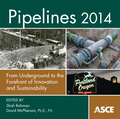Alternative Identification Methodology Maximizes Flexibility in Selecting Preferred Alternative for the Arkansas Valley Conduit
Publication: Pipelines 2014: From Underground to the Forefront of Innovation and Sustainability
Abstract
The proposed Arkansas Valley Conduit (AVC) is a congressionally authorized feature of the Fryingpan-Arkansas (Fry-Ark) Project located in southeastern Colorado. The AVC would be a bulk water supply pipeline designed to supplement or replace existing poor quality water and meet existing and future municipal and industrial water demand in the Lower Arkansas River Basin. Physical features of the AVC would include approximately 370 km (230 mi) of buried pipeline, a water treatment plant, water storage tanks, pump stations, and other related facilities. Forty water providers would participate in the AVC. In 2010, an environmental impact statement (EIS) study was initiated to disclose the potential environmental consequences associated with constructing and operating the AVC. Alternative pipeline routes had to be identified as a part of the EIS process. A structured alternative development and screening process identified a wide range of technical and conceptual options and formulated them into a set of alternatives that address key issues. The purpose of this paper is to describe the four-step process used for the AVC to develop and evaluate alternatives. Because the service area for the AVC is large and involves so many water providers, each with unique connection requirements, the challenge during the alternative analysis stage was to identify alternative corridors that addressed the purpose and need of the project, but did not require an extensive area to analyze for the EIS. Too narrow of a corridor for an alignment would limit the ability to make minor alignment changes based on the results of the EIS process. A corridor too wide could create excessive EIS studies and unnecessary costs and delay the process. An innovative methodology was developed to establish a range of reasonable alternatives meeting the purpose and need of the project. This methodology provided maximum flexibility for identifying and addressing the key needs of the project while minimizing the area needed for the EIS evaluation. This approach proved especially valuable because the final preferred alternative selected ended up being a "hybrid" of various alignment routes and components evaluated during the EIS process. This paper outlines the background, strategies, and process to identify, screen, and evaluate alternatives for the EIS. The paper offers suggestions to facilitate the alternative evaluation process for others who may have similar challenges in the future.
Get full access to this article
View all available purchase options and get full access to this chapter.
Information & Authors
Information
Published In
Copyright
© 2014 American Society of Civil Engineers.
History
Published online: Aug 4, 2014
Authors
Metrics & Citations
Metrics
Citations
Download citation
If you have the appropriate software installed, you can download article citation data to the citation manager of your choice. Simply select your manager software from the list below and click Download.
